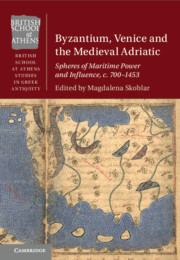36 results
Getting the message right: what are the impacts of counter-serious and organised crime awareness-raising strategies?
-
- Journal:
- Behavioural Public Policy , First View
- Published online by Cambridge University Press:
- 30 April 2024, pp. 1-21
-
- Article
-
- You have access
- Open access
- HTML
- Export citation
Fascist transnationalism during the occupation of Albania (1939–43)
-
- Journal:
- Modern Italy , First View
- Published online by Cambridge University Press:
- 06 February 2024, pp. 1-15
-
- Article
-
- You have access
- Open access
- HTML
- Export citation
26 - National Identity and the Idea of Race in the Dinaric Region
- from Part III - Intersections: National(ist) Synergies and Tensions with Other Social, Economic, Political, and Cultural Categories, Identities, and Practices
-
-
- Book:
- The Cambridge History of Nationhood and Nationalism
- Published online:
- 08 November 2023
- Print publication:
- 09 November 2023, pp 559-577
-
- Chapter
- Export citation
29 - Externalization of Borders
- from Part VIII - Migration Control, Discipline, and Regulation
-
-
- Book:
- The Cambridge History of Global Migrations
- Published online:
- 12 May 2023
- Print publication:
- 01 June 2023, pp 600-620
-
- Chapter
- Export citation
Ecclesiastical Pressures and Language Politics: The Boundary Work of Albanian Language in the 17th-18th Centuries
-
- Journal:
- Nationalities Papers / Volume 50 / Issue 4 / July 2022
- Published online by Cambridge University Press:
- 19 April 2022, pp. 742-769
- Print publication:
- July 2022
-
- Article
- Export citation
Pronoun Usage as a Measure of Power Personalization: A General Theory with Evidence from the Chinese-Speaking World
-
- Journal:
- British Journal of Political Science / Volume 52 / Issue 3 / July 2022
- Published online by Cambridge University Press:
- 18 June 2021, pp. 1258-1275
- Print publication:
- July 2022
-
- Article
-
- You have access
- Open access
- HTML
- Export citation
15 - Reassessing the Venetian Presence in the Late Medieval Eastern Adriatic
-
-
- Book:
- Byzantium, Venice and the Medieval Adriatic
- Published online:
- 26 March 2021
- Print publication:
- 15 April 2021, pp 351-364
-
- Chapter
- Export citation
16 - ‘Strangers in the City?’
-
-
- Book:
- Byzantium, Venice and the Medieval Adriatic
- Published online:
- 26 March 2021
- Print publication:
- 15 April 2021, pp 365-384
-
- Chapter
- Export citation
2 - Prelude: The Balkans 1912–1913
- from Part I - The Fronts
-
- Book:
- Forgotten Wars
- Published online:
- 15 March 2021
- Print publication:
- 01 April 2021, pp 36-60
-
- Chapter
- Export citation

Byzantium, Venice and the Medieval Adriatic
- Spheres of Maritime Power and Influence, c. 700-1453
-
- Published online:
- 26 March 2021
- Print publication:
- 15 April 2021
Bushat, not lost but found: a ‘new’ Illyrian settlement in northern Albania
-
- Article
-
- You have access
- Open access
- HTML
- Export citation
Adherence to healthy and sustainable diets is not differentiated by cost, but rather source of foods among young adults in Albania
-
- Journal:
- British Journal of Nutrition / Volume 126 / Issue 4 / 28 August 2021
- Published online by Cambridge University Press:
- 04 November 2020, pp. 591-599
- Print publication:
- 28 August 2021
-
- Article
-
- You have access
- Open access
- HTML
- Export citation
Hermann von Soden, Alfred Schmidtke et les manuscrits de Bérat
-
- Journal:
- New Testament Studies / Volume 66 / Issue 4 / October 2020
- Published online by Cambridge University Press:
- 24 September 2020, pp. 521-533
- Print publication:
- October 2020
-
- Article
- Export citation
Emerging Needs for Creative Mitigation: Recent Trends in Archaeology and Historic Preservation in Albania
-
- Journal:
- Advances in Archaeological Practice / Volume 8 / Issue 3 / August 2020
- Published online by Cambridge University Press:
- 15 July 2020, pp. 288-298
-
- Article
-
- You have access
- Open access
- HTML
- Export citation
Where to Be in 5 Years? Brain Drain of Psychiatric Trainees – Case of Albania
-
- Journal:
- European Psychiatry / Volume 33 / Issue S1 / March 2016
- Published online by Cambridge University Press:
- 23 March 2020, p. S492
-
- Article
-
- You have access
- Export citation
3 - The Soviet Union and the Socialist Camp
- from Part I - Elusive Unities
-
- Book:
- Cold Wars
- Published online:
- 19 March 2020
- Print publication:
- 19 March 2020, pp 68-89
-
- Chapter
- Export citation
18 - Intellectual Property Rights in Albania:
-
-
- Book:
- Cambridge Handbook of Intellectual Property in Central and Eastern Europe
- Published online:
- 11 June 2019
- Print publication:
- 13 June 2019, pp 328-348
-
- Chapter
- Export citation
INTRAHOUSEHOLD DISTRIBUTION IN MIGRANT-SENDING FAMILIES
-
- Journal:
- Journal of Demographic Economics / Volume 84 / Issue 1 / March 2018
- Published online by Cambridge University Press:
- 06 March 2018, pp. 107-148
-
- Article
- Export citation
A Sea of Difference, a History of Gaps: Migrations between Italy and Albania, 1939–1992
-
- Journal:
- Comparative Studies in Society and History / Volume 60 / Issue 1 / January 2018
- Published online by Cambridge University Press:
- 04 January 2018, pp. 90-118
-
- Article
- Export citation
Grasping the Syrian War, a view from Albanians in the Balkans
-
- Journal:
- Nationalities Papers / Volume 45 / Issue 4 / July 2017
- Published online by Cambridge University Press:
- 20 November 2018, pp. 540-559
- Print publication:
- July 2017
-
- Article
- Export citation



